How to Make Vietnamese Spring Rolls (Gỏi Cuốn)
Meet Arlington of Virginia home Town with Vietnamese girls
1- Army lover 1970

Looking for Little Saigon: Vietnamese Heritage
As the daughter of a U.S. soldier and a Vietnamese woman who met and married during the Vietnam War, Kim has made Vietnamese heritage and immigration a frequent focus of her writing.
https://www.kimaoconnell.com/vietnamese-heritage.html
2- Soldier girl
Kim O' Connell.com/vietnamese-heritage.html

https://www.virginiahumanities.org
As the daughter of a U.S. soldier and a Vietnamese woman who met and married during the Vietnam War, Kim has made Vietnamese heritage and immigration a frequent focus of her writing.
Kim's writing about Vietnamese heritage ranges from the historical to the deeply personal, including essays about her relationship with her mother and journalistic accounts of Vietnamese immigration and heritage, particularly in and around Arlington, Virginia--the first home away from home for the Vietnamese community in the nation's capital. Kim has presented or spoken about this topic to such organizations as WETA-DC (PBS), DCist, the Arlington Historical Society, Leadership Arlington, and American University. She has also appeared in public television programs and videos about Vietnamese heritage.
In Spring 2019, Kim was a Virginia Humanities fellow at the Library of Virginia in Richmond, where she researched, wrote, and spoke on this topic in support of a book project, The Saving Grace of Spring Rolls: A Story of Food, Place, and Family. This blog post details some of Kim's research at the library during the fellowship.
Below is a selection of Kim's previous writings and appearances on this topic.
reach her site:
https://www.kimaoconnell.com/vietnamese-heritage.html
**********************************
Vietnamese
3- booksworm girl
THIEN-KIM
These mix-mariage Vietnamese girls are giving out recipes of Gỏi Cuốn

I’m Thien-Kim. My family lives in the Washington, DC metro area. I love coffee, books, my kids, tech, cooking, and bubble baths.
As the mom of biracial children, I started this site as a way to share the challenges and joys of raising biracial children.
 Thanks for visiting I’m Not the Nanny, where I share the fusion of Asian, African-American cultures in parenting, food, and technology.
Thanks for visiting I’m Not the Nanny, where I share the fusion of Asian, African-American cultures in parenting, food, and technology.Vietnamese

I’ve resisted making this tutorial for a long time even though I’ve received many requests on how to make Vietnamese spring rolls. It’s one of the easiest Vietnamese dishes to make. The ingredients are simply prepared.
Who really needs directions for gỏi cuốn? I asked myself. After speaking with some friends, I realized that it’s the simplicity that mystifies those who devour plates of freshly rolled ones at their Vietnamese restaurant. How could something good be so easy to make?
Each bite is composed of multiple textures: chewy rice wrapper, al dente noodles, savory meat, plus the crunch of cucumbers, carrots and lettuce. Dip them into the sweet, tangy, and salty sauce–that’s comfort in a rice wrapper.

I’ve been rolling gỏi cuốn since I was old enough to handle the rice wrapper. My mom prepared all the ingredients, set them on the dinner table with a bowl of hot water. We filled and rolled each one exactly the way we wanted it. As soon as my kids were old enough, I taught them how to play with their food and assemble their very own–if imperfect–spring rolls.
Now my kids are experts at making gỏi cuốn. They talk about the rolls so often, their teachers have asked me to come in and teach their classmates. Follow along the step-by-step photos and soon you’ll be an expert too.
How to Make Vietnamese Spring Rolls
Ingredients
Let’s talk about ingredients first. A traditional spring roll usually contains:
- rice wrapper
- rice noodles (sometimes called vermicelli noodles)
- fresh vegetables and herbs: usually shredded lettuce, sliced cucumbers, cilantro, Chinese chives
- pork (thinly sliced) and shrimp (cut in half lengthways), quickly boiled in salted water
That’s it. The ingredients aren’t fussy and their true flavors are allowed to shine through. My kids love tofu, so I’ve added sticks of pan fried tofu to our repertoire. If I have time, I season the pork with a five spice powder rub–but that’s entirely optional. We hardly use shrimp unless I remember to buy it.
I won’t tell you want you can or can’t put inside your spring roll. One trend I’ve seen is the tendency to cram too many clashing flavors/ingredients inside the rice wrapper. There’s nothing wrong with simplicity and letting the ingredients’ natural flavors shine.
Need a primer on Vietnamese ingredients? Download my free e-guide to Vietnamese pantry staples.
Assembling a Spring Roll
You can either roll several at a time or make it DIY at the dinner table, like we do. I set out all the ingredients with bowl of very warm water to wet the wrappers. Everyone makes their roll just the way they like.
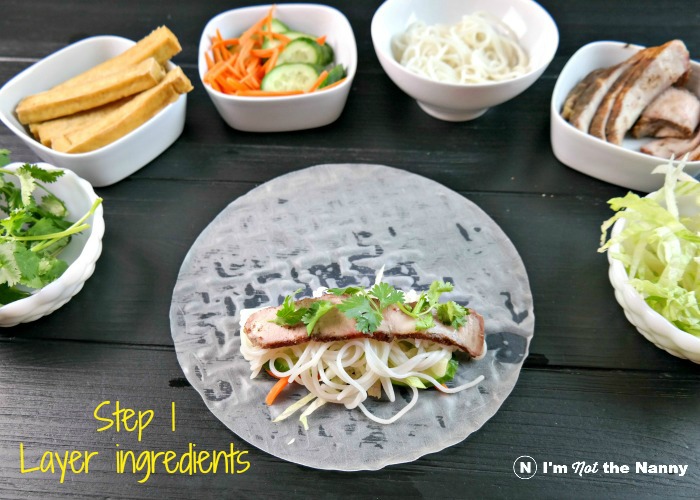
STEP 1: Dip the dry rice wrapper into the hot water, moving quickly to wet both sides entirely. This should take you less than 10 seconds. Let excess water drip off and lay flat on a ceramic or plastic plate. (Don’t use a paper or the wrapper will be too hard to peel off. I learned this the hard way.)
Tip: Careful not to overwet the wrapper. It will slowly absorb the water and become pliable as you add the fillings.
Add your desired filling, leaving a 1.5″ buffer from the outside of the wrapper (see Step 1 photo). I recommend more stable items like cucumbers and lettuce at the bottom. Then top with noodles, add your protein and herbs.
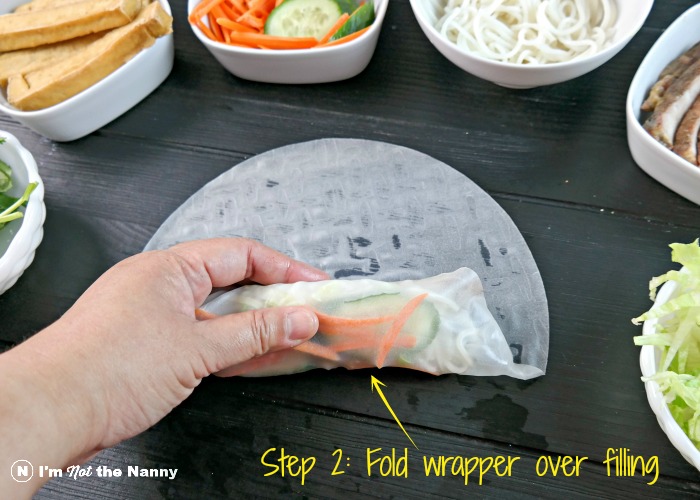
STEP 2: By now, your wrapper should be moist, but not wet and very sticky. Carefully pull the edge nearest to your filling up and over your stack of filling. Complete the roll so that everything is enclosed. The wrapper will stick to itself. Try to make the roll tight but not so much the wrapper will break.

STEP 3: Fold one side over towards the middle. The newly folded side should make a straight edge. Remember, the wrapper will stick to itself. No additional water need.

STEP 4: Repeat with the other side. Your roll is almost finished!

STEP 5: Now that the sides are closed, keep rolling until you reach the end of the wrapper.
Congrats! You’ve successfully made a Vietnamese spring roll!
Make the Dipping Sauce
Now you can decide if you’ll keep making more or just dunk that baby into a bowl of dipping sauce. I personally eat as I make them.
To make the sauce: In a medium bowl, add 1/4 cup of hoisin sauce (I prefer the thicker sauce that comes in a jar) with juice from 1/2 a lime. Mix until lime juice is completely incorporated. Add more lime juice as needed to achieve a balance of tangy and sweet. Optional: add crushed peanuts to sauce.
Hopefully you’ve can see how easy it is to make Vietnamese spring rolls. They’re perfect for those nights when you don’t want to really don’t want to be in the kitchen. The noodles and protein won’t take you long to prep (unless you’re making the fried tofu).
Tip: Make a few extras to pack for lunch. You’ll be glad you did.
If you decide to make gỏi cuốn, post a picture and share it on our Facebook page or tag me on Instagram.
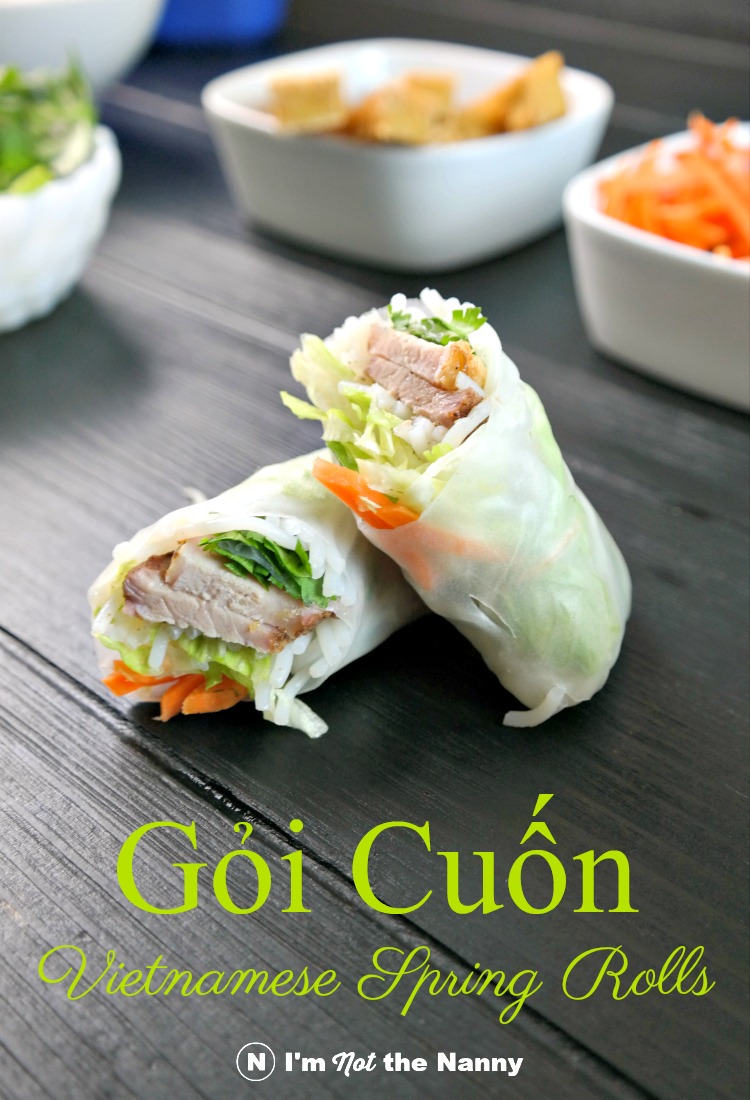
https://www.imnotthenanny.com/2017/10/vietnamese-spring-rolls-goi-cuon.html
====================================================================
5 PANTRY STAPLES FOR VIETNAMESE COOKINGFeatured Vietnamese October 30, 2013
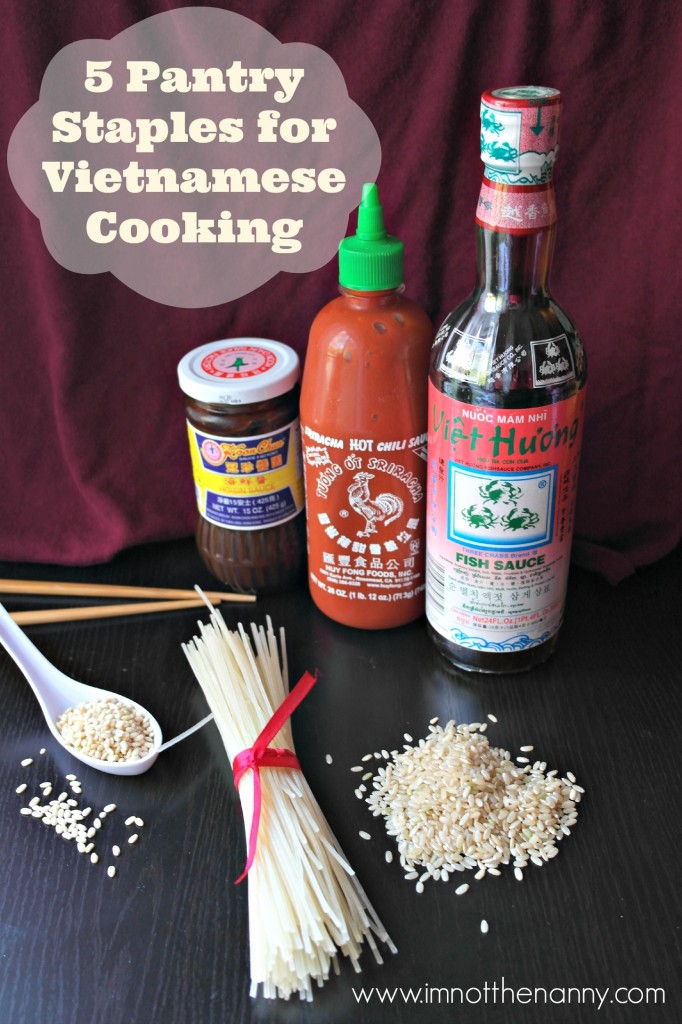
Cooking Vietnamese food doesn’t have to be hard, all you need are these staples in your pantry. After the seeing the painful Top Chef Vietnamese challenge last week, I’m on a mission to share how simple and delicious Vietnamese food is. You would think that the cheftestants would research New Orleans’ cuisine and food history before coming on the show. They would have been better prepared for the Vietnamese food challenge.
Enough ranting about Top Chef. Here are my pantry essentials that I use almost every time I cook Vietnamese food. (Some links are affiliate links.)
1. Fish sauce (Nước mắm). This potent sauce is used sparingly, but provides the umami for most of Vietnamese dishes. It’s either added to the dishes itself during cooking or made into the ubiquitous nước chấm (a sauce made with fish sauce, lime juice, and sugar) that is used for dipping egg rolls or to dress a bowl of bún, a cold noodle dish. My favorite brand is Three Crabs Brand Fish Sauce.
2. Vermicelli rice noodles (Bún). These thin round rice noodles are used in many Vietnamese dishes: Bún, the cold noodle dish topped with meats, sprouts and fresh herbs; spring rolls, where the noodles are encased in a soft rice wrapper; hot noodle soups like the spicy, beefy Bún Bò Huế. I try to buy the brown rice version when I can find it, but usually I get Dragonfly Extra Large Jiangxi Rice Vermicelli.
3. Rice (gạo). Rice is served at almost every meal. If we’re not eating rice we’re eating noodles made from rice. In fact, the Vietnamese language has different terms for rice, based on its form: uncooked, growing in the fields, cooked. My mom has always served jasmine white rice, but I’ve switched to short-grain brown rice (in my effort to eat more whole grains). I always have short-grain brown rice and sweet (sticky) rice (gạo nếp) in my pantry.
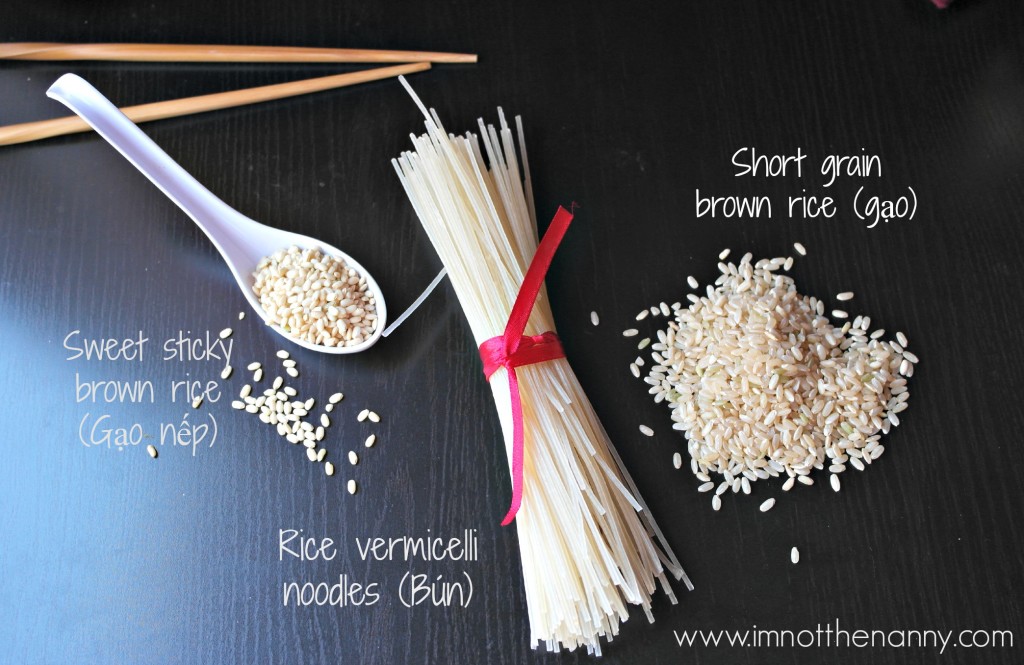
4. Hoisin sauce. If you’ve gone out for phở, the famous Vietnamese noodle soup, you’ve probably squirted this thick sweet sauce into your broth. Not only is it good in soups, but it’s the base for my spring roll sauce. For some reason my friends call it “peanut sauce” because a lot of Viet restaurants blend in the crushed peanuts instead of garnishing the sauce with it. Hoisin is also great for making marinades or Asian-style BBQ sauces. Buy it in the jar because the squeeze bottles are a bit watered down. I prefer Koon Chun Hoisin Sauce.
5. Spices: five spice powder, whole star anise and cloves. Ok, so I’m cheating a little bit. While there are other spices used in the Vietnamese kitchen, these are the ones I use the most. Most of us don’t buy star anise or whole cloves unless it’s for Thanksgiving or Christmas. You’ll need those two to make a fragrant phở broth (yes, you can make phở at home). Five spice powder is also used often in Chinese cooking so now you’ve got a multi-tasker in the kitchen! (For inexpensive spices, check the international aisle in your grocery store.)
I’m also going to assume that you already have soy sauce and Sriricha in your pantry. (If you don’t, you better get on it! There might be a Sriracha shortage soon.) Years ago none of my friends had heard of Sriricha, the garlic chili sauce, but now I see the “Rooster Sauce” everywhere, even in casual dining restaurants. We’ve come a long way.
With those 5 basics, you can start cooking a repertoire of Vietnamese dishes. It’s worth the investment. You should be able to find most of these items in your Asian market or online. Need help with recipes? My go-to Vietnamese cookbooks are Into the Vietnamese Kitchen by Andrea Nguyen and Authentic Vietnamese Cooking: Food from a Family Table by Corinne Trang (sadly out of print but you can buy used copies).
What are your favorite Vietnamese dishes?
December 4, 2019 29 CommentsThis post is sponsored by The Beef Checkoff in conjunction with a social media campaign through Sunday Supper LLC. All opinions are my own.
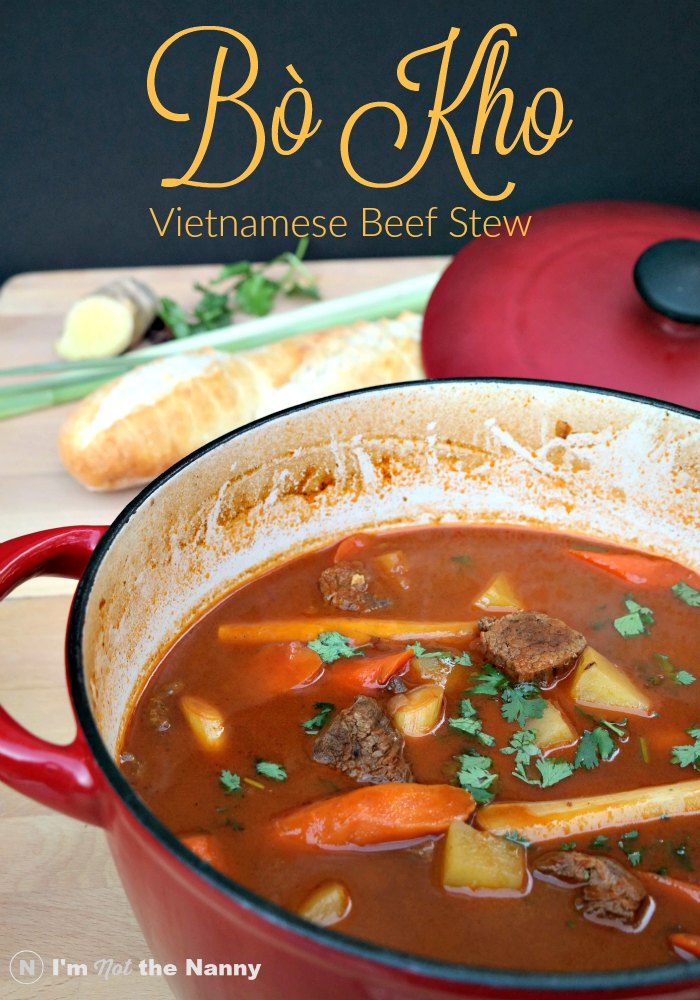
I have fond memories of my mother’s bò kho, a Vietnamese style beef stew. My mother made this stew year round, but I crave it when the weather turns cool. My parents were on a tight budget so the stew stretched the beef with potatoes and carrots. Even after I ate all the beef pieces in my bowl, there was still the vegetables and rich broth.
If you’ve only had American or French style beef stew, you’re missing out. The broth has so many layers of flavor due to the lemongrass, star anise, ginger, and other aromatics.

Most Vietnamese eat the beef stew for breakfast, the same way as we eat phở for our morning meal. As for me, I’m happy to eat this hearty, healthy stew any time of day.
I haven’t eaten a bowl of bò kho in many years, but it’s time to introduce this comfort food dish to my family. There are many variations, but this is my interpretation of my mother’s recipe. She usually serves the stew with warm French bread or over rice noodles. You can serve it over steamed rice.
This Vietnamese beef stew bò kho recipe takes a bit of time to make, but it’s totally worth it. You’ll have a pot large enough for leftovers and your home will smell amazing!

Like this recipe? Download your FREE Vietnamese Pantry Essentials E-Guide.
This Vietnamese beef stew takes a bit of time to make, but it’s totally worth it. In a small bowl set aside 1 tsp five-spice powder, 1 clove minced garlic, 1 tsp ground black pepper. In a large bowl, combine beef, fish sauce, 2 cloves minced garlic, ginger, 1 ½ tsp five-spice powder, and 1 ½ tsp brown sugar. Toss to evenly coat and set aside to marinate for 30 minutes while you peel and chop carrots and potatoes. In a 5-quart Dutch oven, heat over high heat until it shimmers. Brown the beef on all sides by working in small batches: add enough beef to cover the bottom without any overlap. Transfer to a plate before browning the next batch. Lower the heat to medium. Add the onions and cook until fragrant and soft, making sure to stir and scrape up the brown beef bits (approx 5 minutes). Add the tomato paste and stir into onions. Cook for 5 minutes. Add the reserved spice mix from seep #1, lemongrass talks, and star anise. Stir and let it cook uncovered until you can smell all the spices, about 5 minutes. Return the beef to the pot and add coconut juice and water. Bring pot back to a boil, then cover and lower heat. Simmer for about an hour or until the beef is chewy and tender but not falling apart. Add carrots and potatoes. Return to a simmer and cook uncovered until vegetables and beef are tender, about 30 minutes. Taste and add salt or fish sauce as needed. To serve, remove the lemongrass and star anise. Spoon into bowls and garnish with chopped cilantro or Thai basil. Serve with warmed French bread. Alternately, spoon over cooked rice noodles (instead of bread).
Vietnamese Beef Stew (Bò Kho)
Ingredients
Instructions
Healthy Plates with Beef
- Beef and Green Beans over Orange Rice by Cindy’s Recipes and Writings
- Beef Short Ribs with Polenta and Sautéed Greens by Whole Food | Real Families
- Beer Braised Beef Brisket by Life Tastes Good
- Beef Stifado by Recipe for Perfection
- Classic Pot Roast with Lemon and Rosemary by MealDiva
- Easy Stovetop Marsala Roast Beef by Family Foodie
- Filet Mignon with Cherry Sauce by Peanut Butter and Peppers
- Garlic & Herb Prime Rib with Roasted Potatoes & Beets by Momma’s Meals
- Rosemary Garlic Brisket by That Skinny Chick Can Bake
- Sauerbraten by A Kitchen Hoor’s Adventures
- Shank Cut Osso Buco by Recipes Food and Cooking
- Slow Cooker Beef Stew by Bobbi’s Kozy Kitchen
- Slow Cooker Beef Black Bean Chili by Alida’s Kitchen
- Slow Cooker Caribbean Beef Stew by Food Done Light
- Slow Cooker Italian Beef Soup by Meal Planning Magic
- Slow Cooker Steak Fajitas by Daily Dish Recipes
- Spoon Roast with Mushrooms and Farro by Cooking Chat
- Szegediner Gulasch (German Sauerkraut Beef Goulash) by Magnolia Days
- Thai Red Curry with Beef and Butternut Squash by kimchi MOM
- Vietnamese Style Beef Stew by I’m Not the Nanny
Plus 5 Quick Side Dishes for Beef #SundaySupper with The Beef Checkoff.
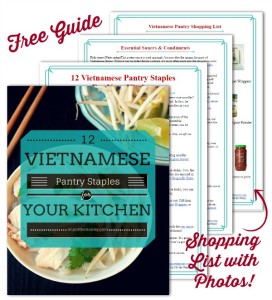




I’ve been wanting to try more Vietnamese recipes so I’m glad you shared this stew one. I can tell by the ingredients that it is full of Asian flavors I enjoy so much.
I love the Asian twist on this beef stew! I can only imagine how fabulous this must taste!
Vietnamese cuisine is a fave of mine. I look forward to giving this a try. It is beautiful!
I have five spice powder in my pantry just waiting for something like this. Amazing recipe!
Perfect! I’ve got another beef recipe with five-spice that’s great on the grill: https://www.imnotthenanny.com/2014/08/easy-vietnamese-steak-recipe.html
What a gorgeous beef stew. Love the Vietnamese twist!
Oh this looks so delicious! It is raining here and this soup is calling my name!!
Perfect soup for a chilly fall night!
It would be fun to have a beef stew put luck where everyone brings their families or their favorite recipe for beef stew.
Can I throw all this in a slow cooker? For how long?
I don’t own a slow cooker, but I imagine you can make this recipe in one. I don’t know about the timing. Cook enough until the beef is tender.
Is there any issues if I don’t use coconut water?
Not at all. You can just substitute with water.
This recipe hit a home run! Best stew I have ever made! Thank you! I added garlic chili sauce for a little kick and substituted the water with beef stock. Truely amazing!
Would it be a disaster if I used coconut milk instead of coconut water?
If you don’t have coconut water, just use regular tap water. I wouldn’t recommend coconut milk.
Hi what does T stand for ? Teaspoon or table ? Thanks
Jenny, T stands for Tablespoon. I’ll update the recipe to make it more clear.
I made this recipe last week for a family dinner exactly as published. The bo kho did not turn out very well and while it had the distinct flavor of bo kho, there was some off flavors. Overall no one like the recipe as published at the cooking club.
This week I made the recipe with some major changes to the recipe and it was some of the best bo kho that the club has ever tasted. Here is the amended recipe for anyone who scrolls this far down.
2 lb beef shanks
1lb stew meat
5 large cloves garlic, minced
3 Tablespoon minced fresh ginger (about 3” knob)
2 ½ tsp Chinese five-spice powder
1 ½ tsp brown sugar
1 tsp ground black pepper
6 Tablespoon fish sauce
3 Tablespoon corn oil
1 medium yellow onion, finely chopped
3 Tablespoon tomato paste
2 whole star anise
1 can of beer
4 cups of water
4 large carrots, peeled and cut into 1-inch chunks
3 large potatoes, peeled and cut into 1-inch chunks
1 baguette
Prepare the stew exactly as above, leave the fat on the bone and add bones to the stew, but once the broth and meat are added to the dutch oven put on the lowest stove settings and let sit for 4-5 hours. When you are ready to add the vegetables do so one hour before you are ready to eat. Put on medium low and add the lid.
Beer! That sounds delicious.
I used to live near a vietnamese restaurant in toronto and would sometimes order this as a departure from my usual favourite bún cha. I’ve since moved to the UK and was craving this so searched for a recipe and found yours. I made it as written except I didn’t have coconut water so used homemade beef bone broth and added somevery coconut oil. It was so delicious! All 4 of my kids gobbled it up, including the baby. Thanks!
Tanya, the bone broth must have made it even more amazing! I’m glad the kids enjoyed it as much as you did.
What about the beef tendons? You gotta have that. It is the best part!
This turned out really well, thanks for the recipe. I loved the food while I was in Vietnam, and brought back lots of star anise, true cinnamon, Vietnamese salt and gorgeous smoked black cardamom pods. I don’t use them or make Vietnamese food as often as I should – thanks for the nudge.
Thank you for publishing this recipe, I’m excited to make it tonight!
Wanted to also say, to people who love the “Asian twist” or “Vietnamese twist” …that is similar to saying your family’s beef stew recipe is a “Twist” on an Asian recipe. Bo Kho is a traditional Vietnamese stew.
I realize this is small, but as a mother, I want my daughter to be proud of the culinary heritage of her father by knowing the difference between traditions, and feeling great that Vietnamese food is getting the popularity it deliciously deserves.
Now, when I make one of my grandmothers Italian dishes and use fish sauce instead of anchovy paste… That is a Vietnamese Twist! 🙂
I invited my niece (Vietnamese) and her husband over for lunch. I made this dish for her. i couldn’t fine lemon grass at any of our local grocery stories, so substituted lemon zest. Awesome results. I made on major mistake. I served over rice. My Niece ate two bowl but let me know not with rice…..
I had this at a Vietnamese restaurant in Melbourne Australia and loved it. As an absolute fan of Viet food, I Googled a recipe and came up with this. Absolutely sensational. Made exactly to your recipe and it was two thumbs up for everyone who tried to!
The timing at the top of the recipe is off by 2hours 30 minutes. If you add up the cooking time dictated including the prep and actual times totals 2 hours thirty minutes and not the 5 hours shown.
Thanks for catching that, Dom! It’s been fixed.
Vietnamese Beef Stew (Bò Kho) Recipe #SundaySupperhttps://www.imnotthenanny.com/2019/12/vietnamese-beef-stew-bo-kho-recipe.html